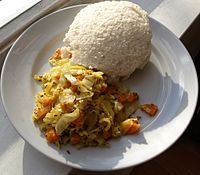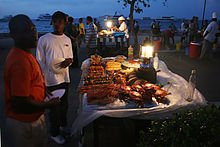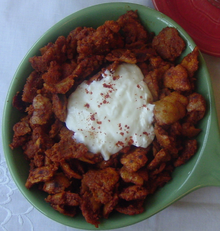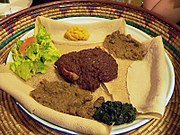
Ugali is pictured here with a side dish of cabbage, though it is more typically eaten with collard greens (sukuma wiki).

Barbecued beef cubes and seafood in Forodhani Gardens, Zanzibar

Kitcha fit-fit, a mainstay in Ethiopian cuisine, is presented with a scoop of fresh yoghurt and topped with berbere (spice).

The cuisine of East Africa varies from area to area. In the inland savannah, the traditional cuisine of cattle-keeping peoples is distinctive in that meat products are generally absent. Cattle, sheep, pigs and goats were regarded as a form of currency[14] and a store of wealth, and are not generally consumed as food.[citation needed]
In some areas, traditional East Africans consume the milk and blood of cattle, but rarely the meat. Elsewhere, other peoples are farmers who grow a variety of grains and vegetables. Maize (corn) is the basis of ugali, the local version of West and Central Africa's fufu. Ugali is a starch dish eaten with meats or stews. In Uganda, steamed green bananas called matoke provide the starch filler of many meals.[citation needed]
Around 1000 years ago, Omani and Yemeni merchants settled on the Swahili Coast. Middle Eastern influences are especially reflected in the Swahili cuisine of the coast—steamed or cooked rice with spices in Persian style; saffron, cloves, cinnamon and several other spices; and pomegranate juice.[15]
Several centuries later, the British and the Indians came, and both brought with them foods such as Indian spiced vegetable curries, lentil soups, chapattis and a variety of pickles which have influenced various local dishes. Some common ingredients used in this region include oranges, lemons, limes, chillis, capsicum peppers, maize, tomatoes, and strawberries.
In the Horn of Africa, the main traditional dishes in Eritrean cuisine and Ethiopian cuisine are tsebhis (stews) served with injera[2][16] (flatbread made from teff,[16] wheat, or sorghum) and hilbet (paste made from legumes, mainly lentils and fava beans). Eritrean and Ethiopian cuisine (especially in the northern half) are very similar, given the shared history of the two countries.
Eritrean and Ethiopian food habits vary regionally. In the highlands, injera is the staple diet and is eaten daily among the Tigrinya. Injera is made out of teff, wheat, barley, sorghum or corn, and resembles a spongy, slightly sour pancake. When eating, diners generally share food from a large tray placed in the center of a low dining table. Many injera are layered on this tray and topped with various spicy stews. Diners then break into the section of injera in front of them, tearing off pieces and dipping them into the stews.
In the lowlands, the main dish is akelet, a porridge-like dish made from wheat flour dough. A ladle is used to scoop out the top, which is filled with berbere and butter sauce and surrounded by milk or yoghurt. A small piece of dough is broken and then used to scoop up the sauce.

Typical Ethiopian and Eritrean cuisine: Injera (pancake-like bread) and several kinds of wat (stew)
The best known Ethio-Eritrean cuisine consists of various vegetable or meat side dishes and entrées, usually a wat, or thick stew, served atop injera, a large sourdough flatbread made of teff flour. One does not eat with utensils, but instead uses injera to scoop up the entrées and side dishes.
Tihlo, prepared from roasted barley flour, is very popular in Amhara, Agame, and Awlaelo (Tigray). Traditional Ethiopian cuisine employs no pork or shellfish of any kind, as they are forbidden in the Jewish and Ethiopian Orthodox Christian faiths. It is also very common to eat from the same dish in the center of the table with a group of people.
Xalwo, the Somali version of halva, is a festive dish in Somali cuisine.
Somali cuisine varies from region to region and consists of an exotic mixture of diverse culinary influences. It is the product of Somalia's rich tradition of trade and commerce. Despite the variety, there remains one thing that unites the various regional cuisines: all food is served halal. There are therefore no pork dishes, alcohol is not served, nothing that died on its own is eaten, and no blood is incorporated. Qaddo or lunch is often elaborate.
Varieties of bariis (rice), the most popular probably being basmati, usually serve as the main dish. Spices like cumin, cardamom, cloves, cinnamon and sage are used to aromatize these different rice dishes. Somalis serve dinner as late as 9 pm. During Ramadan, dinner is often served after Tarawih prayers, sometimes as late as 11 pm.
Xalwo (halwo) or halva is a popular confection served during special occasions such as Eid celebrations or wedding receptions. It is made from sugar, cornstarch, cardamom powder, nutmeg powder, and ghee. Peanuts are also sometimes added to enhance texture and flavor.[17] After meals, homes are traditionally perfumed using frankincense (lubaan) or incense (cuunsi), which is prepared inside an incense burner referred to as a dabqaad.